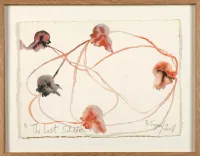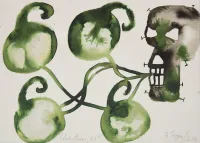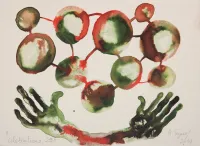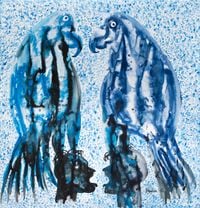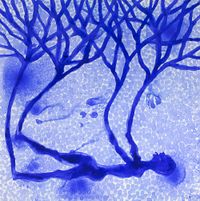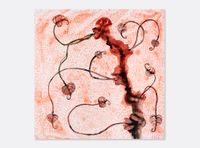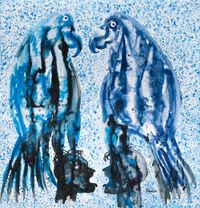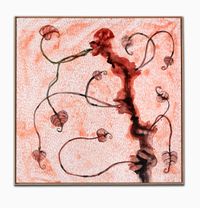Charged by a number of deeply political themes such as migration, colonialism, and race, Barthélémy Toguo is interested in destabilising common notions of the world by creating representations that are stranger and differently nuanced.
Read MoreToguo has found his home in a range of media. In watercolour—a medium he has frequently returned to—he toys with the borders between saturation and drought, between the real and the fantastic, between identities and species. He has described watercolour as a medium 'you cannot cheat' and believes it produces intimate and sincere expressions of the artist's spirit. For 'Baptism' (1999) he created a set of monochromatic images depicting strange scenes in which, for example, feathers sprout from a human silhouette or a man urinates in a bathtub, evoking surreal narratives in which the mundane and the horrific sit side-by-side.
When Toguo was young, his home-country of Cameroon had no arts institutions. He attended Ecole Nationale Supérieure des Beaux Arts in the nearby Côte d'Ivoire after a childhood spent drawing market scenes and modelling cargo trucks in bamboo. He later studied in France, discovering a passion for video, photography, and—later, during studies in Germany—performance art. He ultimately settled between Bandjoun and Paris. In Cameroon in 2008, he opened the Bandjoun Station—a non-profit creative workshop—as a grassroots solution to the nation's lack of arts infrastructure.
Toguo's decision to work between continents matches his interest in the relationships between political circumstances. In Urban Requiem—exhibited in the Venice Biennale's 56th International Art Exhibition, All the World's Futures—the artist presented 105 wooden stamps, each carrying a message such as 'DON'T SHOOT' (referring to various racially motivated shootings in the United States) and 'NOT IN MY NAME' (referring to a protest slogan used after a series of murders of Muslim and Dalit people). The phrases were stamped onto papers pinned throughout the space. This 'urban requiem', according to the artist, represents 'the great cry of those who are suffering'. He calls for a sense of unity, stating, 'The whole world is at stake here'.
Toguo also reflected on global responsibility in his Prix Marcel Duchamp 2016 finalists' exhibition installation, Vaincre le virus! ('Beating the virus!'), which included 18 Jingdezhen ceramic vases depicting viruses, flowers, animals, and self-portraits. The work celebrates research efforts towards curing AIDS and Ebola, with a particular focus on the Institut Pasteur in France and its sister organisation in Dakar. Reflecting on the research of institutions across two countries (France and Senegal) in the symbolism and production methods of a third country (China), the artist showed once again that the world is connected and collectively 'at stake'.
Casey Carsel | Ocula | 2019
